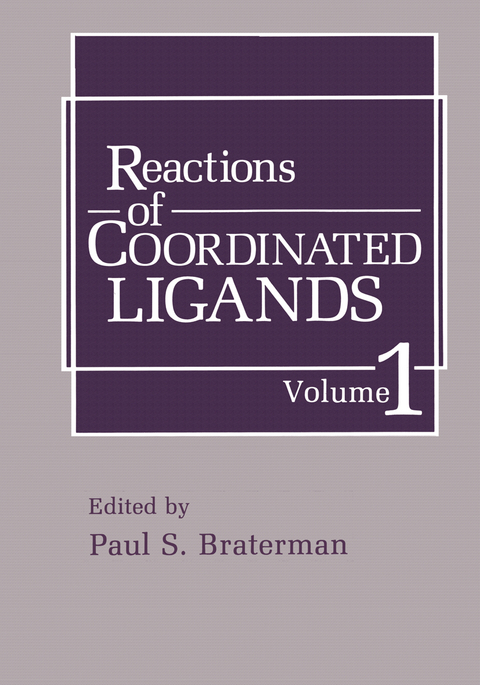
Reactions of Coordinated Ligands
Kluwer Academic/Plenum Publishers (Verlag)
978-0-306-42201-0 (ISBN)
- Titel z.Zt. nicht lieferbar
- Versandkostenfrei innerhalb Deutschlands
- Auch auf Rechnung
- Verfügbarkeit in der Filiale vor Ort prüfen
- Artikel merken
1. One-Carbon, Two-Carbon and Three-Carbon Ligands.- 1. General.- 2. Thermochemical Studies.- 3. One-Carbon Ligands.- 4. Alkene Complexes.- 5. Formation and Reactions of n3-Allyl Complexes.- 6. More Recent Developments.- References.- 2. Reactions of One-Carbon Ligands in Complexes of Macrocycles.- 1. Types of Ligand Encountered.- 2. Homolytic Cleavage of the Carbon-Metal Bond.- 3. Reactions with Electrophiles.- 4. Reactions with Nucleophiles.- 5. Unimolecular Rearrangements.- 6. Summary.- References.- 3. Alkylidene Complexes of the Earlier Transition Metals.- 1. Introduction.- 2. Types and Methods of Preparation.- 3. NMR and IR Studies.- 4. Structural Studies.- 5. Decomposition Studies.- 6. Reactions.- 7. Calculations.- 8. Recent Developments.- References.- 4. Carbene Complexes of Groups VIA, VIIA and VIII.- 1. Introduction.- 2. Synthesis.- 3. Structure and Bonding.- 4. Reactions with Nucleophiles.- 5. Reactions with Electrophiles.- 6. Reactions of Transition Metal Carbene Anions.- 7. Addition-Rearrangement Reactions.- 8. Redox Reactions without Metal Carbene Cleavage.- 9. Cleavage of the Metal Carbene Bond.- 10. Carbene Transfer Reactions.- 11. Carbonyl Carbene Complexes as Bifunctional Reagents.- 12. Carbonyl Carbene Complexes in Organic Synthesis.- 13. More Recent Developments.- References.- 5. Mechanistic Aspects of the Olef in Metathesis Reaction.- 1. Introduction.- 2. The Metallo-Carbene Mechanism.- 3. Mode of Formation of the First Metallo-Carbene.- 4. The Metalla-Cyclobutane and Metalla-Cyclobutene Intermediates.- 5. Sterochemistry of the Reaction.- 6. Electronic Nature of the Chain-carrying Carbene in Olefin Metathesis.- 7. Conclusions.- References.- 6. Carbonylation and Related Chemistry: Some General Aspects.- 1. General.- 2. The Carbon Monoxide Insertion Reaction.- 3. External Nucleophilic Attack on CO.- 4. Metal Acyls as Bases.- 5. n2-Bound Acyl Ligands and Related Species.- 6. Aldehyde-Hydridoacyl Interconversions.- 7. Ketone Elimination Reactions.- 8. Miscellaneous.- 9. More Recent Developments.- References.- 7. Promotion Effects in Transition Metal-Catalyzed Carbonylation.- 1. Introduction.- 2. Substrate Structure and Substituent Effects.- 3. Ligands.- 4. Solvent, Ion Pair, Acid and Base Effects.- 5. Oxidants and Reductants.- 6. More Recent Developments.- References.- 8. Hydride Transfer to Coordinated Carbon Monoxide and Related Ligands.- 1. Introduction.- 2. The Carbon Monoxide Ligand.- 3. The Carbon Monosulfide Ligand.- 4. The Carbon Monoselenide and Carbon Monotelluride Ligands.- 5. The Isocyanide Ligand.- 6. Conclusion.- 7. More Recent Developments.- References.- 9. Reactions of Coordinated Isocyanides.- 1. Introduction.- 2. Bonding and Reactivity.- 3. Substitution Reactions.- 4. Reactions with Nucleophiles.- 5. Reactions with Electrophiles.- 6. Insertion Reactions.- 7. Organic Synthesis via Metal-Isocyanide Complexes.- References.- Additional References.- 10. The Formation and Reactions of Metallacycles.- 1. Introduction.- 2. Formation.- 3. Reactions.- 4. Metallacycles as Intermediates.- 5. More Recent Developments.- 6. Conclusions.- References.- 11. Nucleophilic Attack on Coordinated Alkenes.- 1. Introduction.- 2. Palladium and Platinum Olefin Complexes.- 3. Nickel Olefin Complexes.- 4. Cobalt and Rhodium Olefin Complexes.- 5. Iron Olefin Complexes.- 6. Ruthenium and Osmium Olefin Complexes.- 7. Manganese and Rhenium Olefin Complexes.- 8. Molybdenum and Tungsten Olefin Complexes.- 9. Applications in Organic Synthesis.- References.- 12. Asymmetric Additions to Double Bonds.- 1. Introduction.- 2. Asymmetric Hydrogenation.- 3. Asymmetric Hydrosilylation.- 4. Asymmetric Hydroformylation.- 5. Other Asymmetric Addition Reactions.- 6. Some More Recent Results.- References.- 13. Reactions of Coordinated Acetylenes.- 1. Introduction.- 2. Structures, Bonding and Reactivity.- 3. Reactions of Coordinated Acetylenes.- References.- 14. Nucleophilic Attack on Unsaturated Hydrocarbons Coordinated to Transition Metals.- 1. Introduction.- 2. Nucleophilic Addition to Organotransition Metal Cations.- References.- 15. Reactions of Coordinated Dienes.- 1. Introduction.- 2. Electrophilic Addition and Substitution.- 3. Nucleophilic Addition Reactions.- 4. Cycloaddition Reactions.- 5. Ligand Isomerization Reactions.- 6. Catalytic Transformations of Conjugated Dienes.- 7. More Recent Developments.- References.- 16. Reactions of Five-Carbon and Larger Ligands.- 1. Scope of the Chapter.- 2. Nucleophilic attack on Coordinated Ligands.- 3. Electrophilic attack on n5-, n6-and n7-Complexes.- 4. Metalation Reactions.- 5. Side Chain and Other Organic Reactions of n6-Chromium Complexes.- 6. Redox Reactions.- 7. n6-Borabenzene Complexes.- References.- Abbreviations.
| Erscheint lt. Verlag | 30.9.1987 |
|---|---|
| Zusatzinfo | 1064 p. |
| Sprache | englisch |
| Themenwelt | Naturwissenschaften ► Chemie ► Anorganische Chemie |
| Naturwissenschaften ► Chemie ► Organische Chemie | |
| ISBN-10 | 0-306-42201-8 / 0306422018 |
| ISBN-13 | 978-0-306-42201-0 / 9780306422010 |
| Zustand | Neuware |
| Haben Sie eine Frage zum Produkt? |
aus dem Bereich


